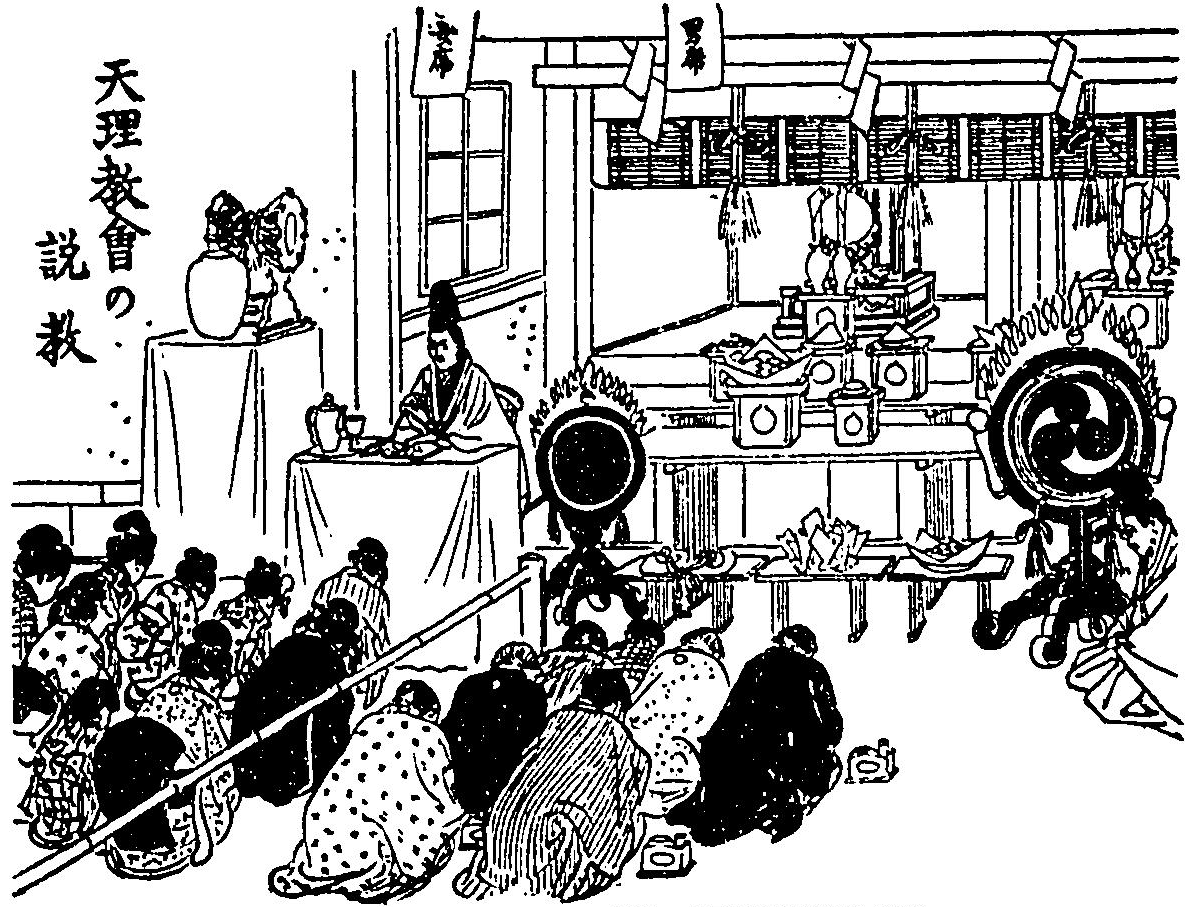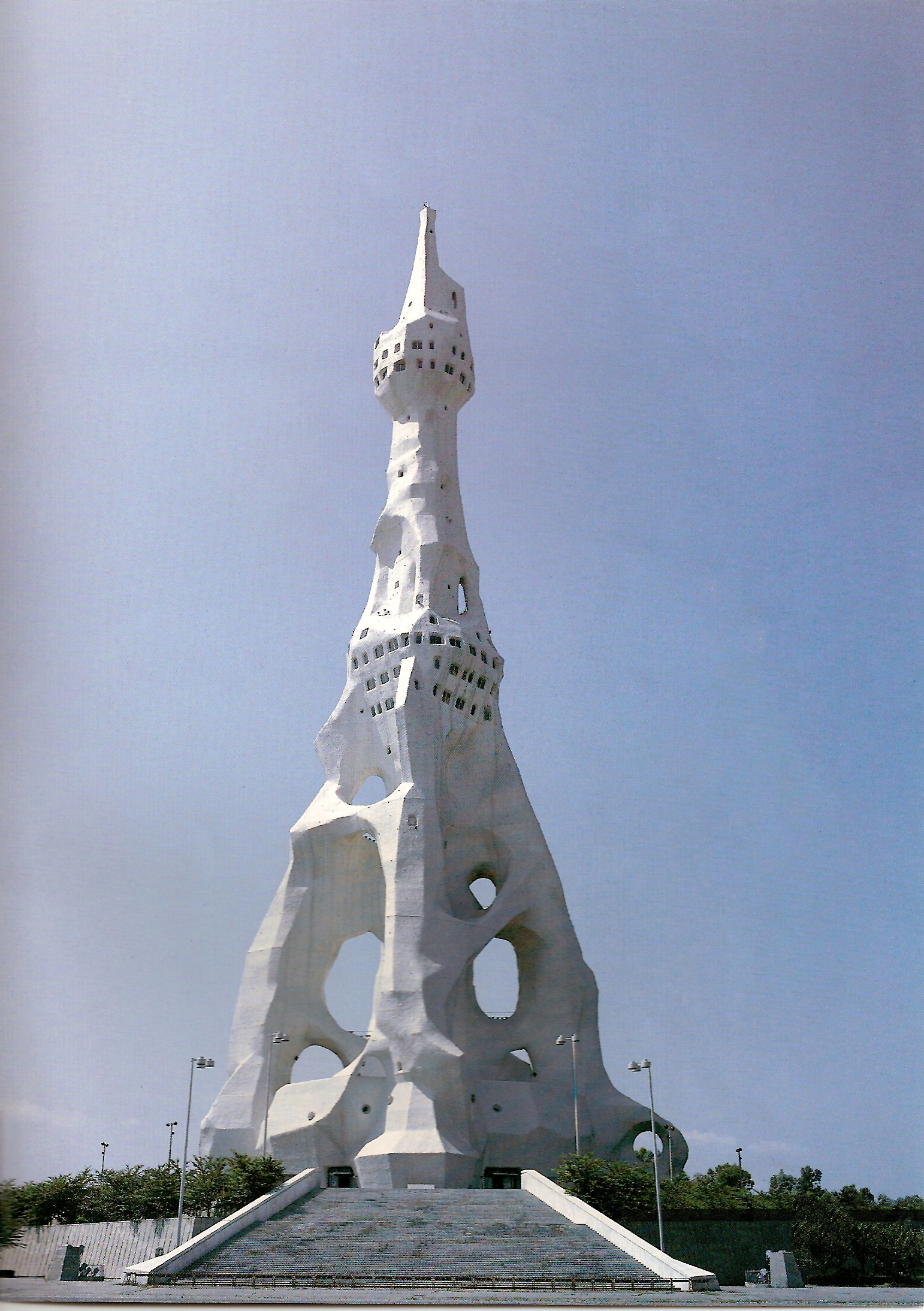|
Honmichi
(also 本道 or 天理本道, ) is a Tenrikyo-based ''shinshūkyō'' (Japanese new religion). Honmichi became formally independent in 1925 under its founder, Ōnishi Aijirō (大西愛治郎), also known by the title . Despite the religion being derived from Tenrikyo with a different interpretation of doctrines such as , Honmichi's religious structure still maintains the same basic overall characteristics as Tenrikyo. It was reorganized from the earlier . It had 319,031 followers in 2022 according to the Reiwa 4 (2022Religion Almanacpublished by the Agency for Cultural Affairs. Scriptures and practices Honmichi considers itself, rather than Tenrikyo, to be the true, original religion of Nakayama Miki. Devout Honmichi members are called rather than ''yōboku'' (ようぼく) as in Tenrikyo. The term ''Honmichi'' comes from the '' Ofudesaki'' and can be found in ''Ofudesaki'' 1:49, 3:37, 4:75-77, 5:30, 5:82, 6:17, 6:28, and 17:22. Some of the main scriptures used in Honmichi in ... [...More Info...] [...Related Items...] OR: [Wikipedia] [Google] [Baidu] |
Ōnishi Aijirō
Ōnishi Aijirō (大西 愛治郎, August 26, 1881 – November 29, 1958) was a Japanese religious leader known as the founder of Honmichi, a Tenrikyo-based ''Japanese new religions, Shinshūkyō'' (Japanese new religion). Honmichi followers also refer to him as the . Life Ōnishi Aijirō was born on August 26, 1881 in Uda, Nara as the youngest child of Kishioka Kichijirō (岸岡吉次郎) and Kisa (キサ). His grandfather was Eijirō. Prior to his divine revelation in 1913, Aijirō served a Tenrikyo missionary. From 1907 to 1914, he was the head minister of the in Yamaguchi (city), Yamaguchi. He was poorly funded and suffered from many financial difficulties, including crippling debts. On July 15, 1913, Ōnishi Aijirō, who was in Yamaguchi at the time, went into trance with his family. He proclaimed himself as the living ''kanrodai'' with the words, "This is where the Kanrodai stands" (此処は甘露台や). Ōnishi then returned to Nara Prefecture and became a worker a ... [...More Info...] [...Related Items...] OR: [Wikipedia] [Google] [Baidu] |
Kanrodai
The ('stand for the heavenly dew', or ) is a sacred entity in Tenrikyo and Tenrikyo-derived Japanese new religions, including (but not limited to) Honmichi, Honbushin, Kami Ichijokyo, Tenri Sanrinkō, and Daehan Cheolligyo. Tenrikyo, as well as a few of its schisms such as , considers the kanrodai to be a physical pillar. However, later Tenrikyo-derived schisms such as Honmichi, Kami Ichijokyo, and Tenri Sanrinkō give a new interpretation in which the kanrodai is embodied as a living person. Honbushin has installed a small stone kanrodai on Mount Kami (Okayama), Kamiyama, a mountain in Okayama, and also recognizes a human kanrodai who is the son of its founder Ōnishi Tama. The first kanrodai was built in 1873 by Iburi Izō at Nakayama Miki's residence. Origin The concept of the kanrodai was first taught by Nakayama Miki, the foundress of Tenrikyo, in 1868. In 1873, she instructed her disciple Iburi Izō, who was a carpenter by trade, to make a wooden kanrodai. Before the locatio ... [...More Info...] [...Related Items...] OR: [Wikipedia] [Google] [Baidu] |
Ōnishi Tama
Ōnishi Tama (大西 玉, November 19, 1916 – September 1, 1969) was a Japanese religious leader known as the founder of Honbushin, a Tenrikyo-based (Japanese new religion). She was the daughter of Ōnishi Aijirō, who had founded the Honmichi religion in 1913. Honbushin followers believe that she is the reincarnation (再生, ''saisei'') of Tenrikyo founder Nakayama Miki (1798–1887), a claim that Ōnishi Tama and her father Ōnishi Aijirō had maintained since her birth. In the Honbushin religion, she is known as Miroku (みろく) or Miroku-sama (みろく様), and also as Tamahime-sama (玉姫様). Life Birth Ōnishi Tama was born to Ōnishi Aijirō in 1916 in Uda, Nara Prefecture. Just three years earlier, Ōnishi Aijirō had received a divine revelation in which God, as (), told Ōnishi Aijirō that he was the living kanrodai, or sacred pillar embodied in a human body. In 1916, when his wife To'o became pregnant with their fourth child, Ōnishi Aijirō clai ... [...More Info...] [...Related Items...] OR: [Wikipedia] [Google] [Baidu] |
Honbushin
(or 本普請, ) is a Tenrikyo-based ''Japanese new religions, shinshūkyō'' (Japanese new religion) founded on April 26, 1961 by Ōnishi Tama (大西玉), also known as "Miroku-sama" (みろく様) in the religion. It is headquartered in Okayama, Japan. History On April 26, 1961, Honmichi founder Ōnishi Aijirō's daughter Ōnishi Tama (大西玉; 1916–1969) (whom Aijirō and Honbushin followers consider to be the reincarnation of Nakayama Miki), founded Tenri Miroku-kai (天理みろく会, "Tenri Miroku Association"), which would later be renamed as Honbushin. In 1962, the organization separated from Honmichi. It was incorporated as a religious organization in 1966. Originally, it was headquartered in Takaishi, Osaka near the Honmichi headquarters, but then moved to Shiojiri, Nagano. In 1969, Honbushin moved to Okayama, where it set up its ''kanrodai'' on top of Mount Kami (Okayama), Mount Kami, southeast of the Okayama city center. Ōnishi Tama died on September 1, 1969, a ... [...More Info...] [...Related Items...] OR: [Wikipedia] [Google] [Baidu] |
Sennan, Osaka
is a city located in Osaka Prefecture, Japan. , the city had an estimated population of 60,318 in 26214 households and a population density of 1200 persons per km2. The total area of the city is . Geography Sennan is located in the southwestern part of Osaka prefecture. The northwest portion of the city is bordered by Osaka Bay and the southeastern portion borders the Izumi Mountains and Wakayama Prefecture. About one-third of the southern part of Kansai International Airport is within the borders of Sennan city, contributing to the city's economy,OSAKA KANSAI (Kansai International Airport) " . Retrieved on July 23, 2011. "Departure JAL Export Cargo Bldg. 1 Senshu Airport M ... [...More Info...] [...Related Items...] OR: [Wikipedia] [Google] [Baidu] |
Tenrikyo
is a Japanese new religion which is neither strictly monotheistic nor pantheistic, originating from the teachings of a 19th-century woman named Nakayama Miki, known to her followers as "Oyasama". Followers of Tenrikyo believe that God of Origin, God in Truth, known by several names including "Tsukihi," " Tenri-Ō-no-Mikoto" and "Oyagamisama" revealed divine intent through Miki Nakayama as the Shrine of God and to a lesser extent the roles of the Honseki Izo Iburi and other leaders. Tenrikyo's worldly aim is to teach and promote the Joyous Life, which is cultivated through acts of charity and mindfulness called . The primary operations of Tenrikyo today are located at Tenrikyo Church Headquarters, which supports 16,833 locally managed churches in Japan,Japanese Ministry of Education. ''Shuukyou Nenkan, Heisei 14-nen'' (宗教年鑑平成14年). 2002. the construction and maintenance of the and various community-focused organisations. It has 1.75 million followers in Japan a ... [...More Info...] [...Related Items...] OR: [Wikipedia] [Google] [Baidu] |
Japanese New Religion
Japanese new religions are new religious movements established in Japan. In Japanese, they are called or . Japanese scholars classify all religious organizations founded since the middle of the 19th century as "new religions"; thus, the term refers to a great diversity and number of organizations. Most came into being in the mid-to-late twentieth century and are influenced by much older traditional religions including Buddhism and Shinto. Foreign influences include Christianity, the Bible, and the writings of Nostradamus. Before World War II In the 1860s, Japan began to experience great social turmoil and rapid modernization. As social conflicts emerged in this last decade of the Edo period, known as the Bakumatsu period, some new religious movements appeared. Among them were Tenrikyo, Kurozumikyo, and Oomoto, sometimes called () or "old new religions", which were directly influenced by Shinto (the State Shinto, state religion) and shamanism. The social tension continued to gr ... [...More Info...] [...Related Items...] OR: [Wikipedia] [Google] [Baidu] |
Ofudesaki
The Ofudesaki (おふでさき or 御筆先, "Tip of the Writing Brush") is the most important scripture in Tenrikyo. It is one of Tenrikyo's three scriptures (''sangenten'' 三原典), along with the '' Mikagura-uta'' ("The Songs for the Service") and the '' Osashizu'' ("Divine Directions"). A 17-volume collection of 1,711 '' waka'' poems, the Ofudesaki was composed by the foundress of Tenrikyo, Miki Nakayama, from 1869 to 1882. The Ofudesaki as composed by Miki Nakayama is also the primary sacred scripture of most Tenrikyo-derived religions, including Honmichi, Honbushin, Kami Ichijokyo, among others. Etymology and meaning The name ''Ofudesaki'' can be split into three smaller segments. ''O'' is an honorific prefix, '' fude'' translates to "brush," and ''saki'' translates to "tip." Thus, the Ofudesaki has been referred to in English as ''The Tip of the Writing Brush.'' It was even once referred to as "The Book of Revelations" in early English Tenrikyo literature. It is ... [...More Info...] [...Related Items...] OR: [Wikipedia] [Google] [Baidu] |
Mikagura-uta
The Mikagura-uta (みかぐらうた or 御神楽歌, ''The Songs for the Service'') is one of the three Tenrikyo scriptures, along with the '' Ofudesaki'' and the '' Osashizu''. It was composed by the foundress of Tenrikyo, Miki Nakayama, from 1866 to 1875, and revised to its current version in 1882. The Mikagura-uta is the liturgical book of the Service (''otsutome''), a religious ritual that has a central place in Tenrikyo. During the Service, the text to the ''Mikagura-uta'' is sung together with dance movements and musical accompaniment. The Mikagura-uta is also used in most Tenrikyo-derived religions, including Honmichi, Honbushin, Kami Ichijokyo, among others. Etymology and meaning "Mikagura-uta" can be subdivided into three sections. ''Mi'' is an honorific prefix. The word ''kagura'' is a generic term for any performance for a deity or deities in Japan. Although ''kagura'' are usually associated with Shinto shrines, there is also historical evidence of their associatio ... [...More Info...] [...Related Items...] OR: [Wikipedia] [Google] [Baidu] |
Takaishi, Osaka
260px, Takaishi Shrine is a city located in Osaka Prefecture, Japan. , the city had an estimated population of 55,232 and a population density of 4,888 persons per km2. The total area of the city is . Geography Takaishi is located in the south-central part of Osaka Prefecture, bordered by Osaka Bay to the west, Sakai City ( Nishi Ward ) to the northeast, and Izumi City and Izumiotsu City to the south. Almost the entire city area is flat and is completely urbanized. Roughly 6.1 kilometers east–west by 4.1 kilometers north–south, it is the second smallest city in terms of area in Osaka prefecture after Fujiidera. The western half of the city is reclaimed land and is part of the Sakai Senboku Seaside Industrial Zone. It is traversed by both the Ashida and Oji Rivers. Neighboring municipalities Osaka Prefecture * Izumi * Izumiōtsu *Sakai Climate Takaishi has a Humid subtropical climate (Köppen ''Cfa'') characterized by warm summers and cool winters with light to no snowfal ... [...More Info...] [...Related Items...] OR: [Wikipedia] [Google] [Baidu] |
Nakayama Miki
was a nineteenth-century Japanese farmer and religious leader. She is the primary figure of the Japanese new religion Tenrikyo. Tenrikyo followers, who refer to her as Oyasama (おやさま or 親様), believe that she was settled in the Shrine of Tsukihi from the moment she experienced a divine revelation in 1838 until her death in 1887. In Tenrikyo, she is also referred to as the . Upon her divine revelation, she gave away most of her family's possessions and dismantled the family's house, thereby entering a state of poverty. She began to attract followers, who believed that she was a living goddess who could heal people and bless expectant mothers with safe childbirth. To leave a record of her teachings, she composed the '' Ofudesaki'' and taught the lyrics, choreography and music of the Service, which have become Tenrikyo's scripture and liturgy respectively. She identified what she claimed to be the place where God created human beings and instructed her followers to mar ... [...More Info...] [...Related Items...] OR: [Wikipedia] [Google] [Baidu] |





